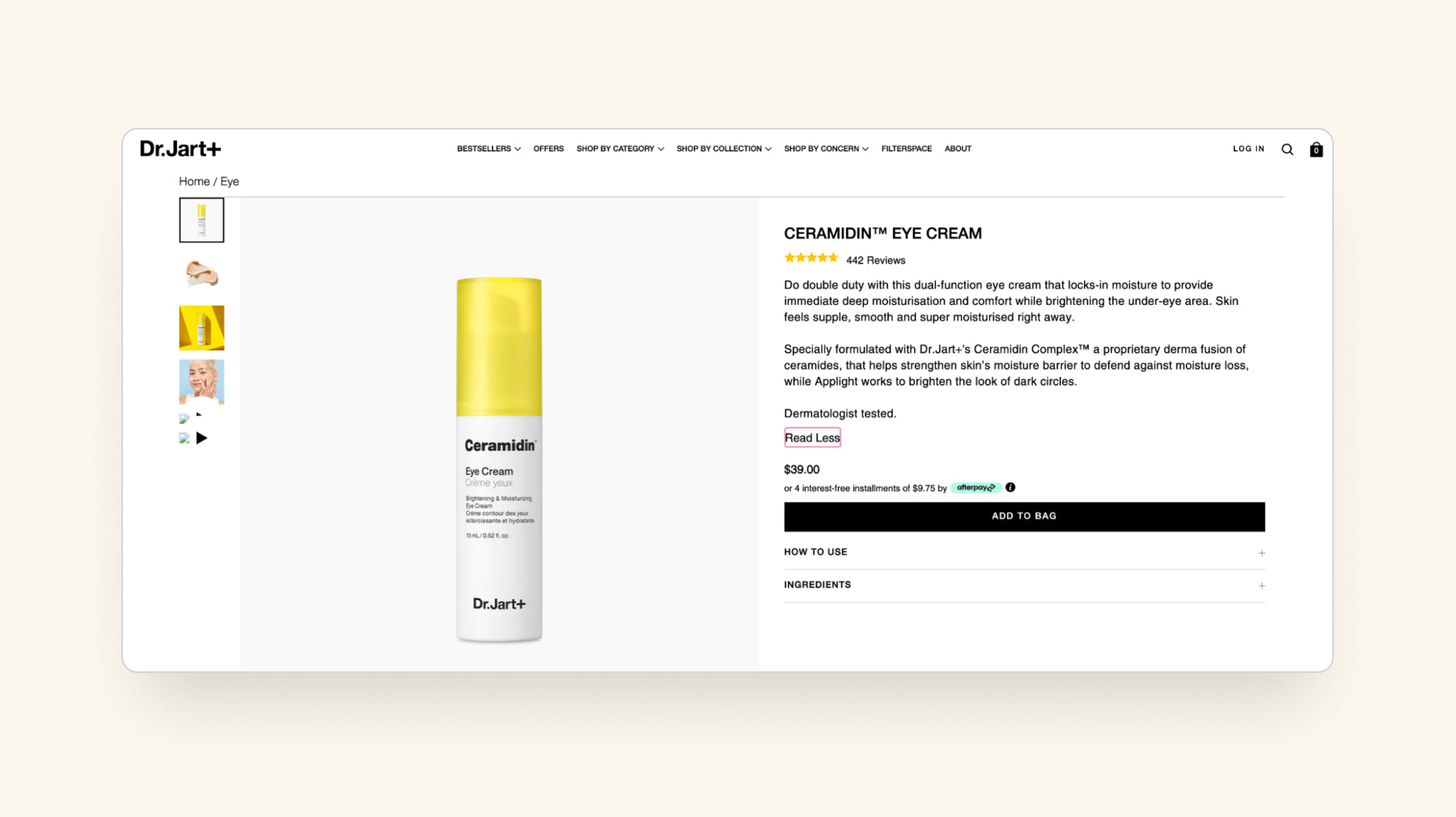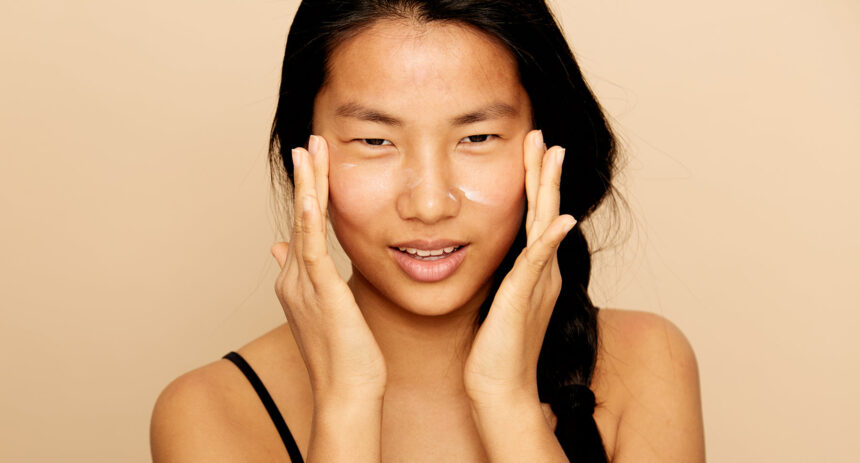If you’re selling creams, serums, soaps, or other skin and hair care products online, having a killer skin care branding and marketing plan is one of the highest-impact ways you can increase sales and get your products out there.
Successful marketing plans can include campaigns on social media, working with influencers, and creating content—and we’ll get to that!—but it starts with the foundations of your company. That means your brand, your product descriptions, and how you differentiate yourself from competitors.
Knowing your business’ unique voice and who you’re selling to are the first steps in figuring out how to market your brand. Every skin care brand is different in how it chooses its customers, its look, and its selection of products.
That said, there are shared traits across skin care companies, and it’s worth examining the most meaningful similarities to ask: What should a product page look like? What details do customers want highlighted? How do customers discover their next favorite product?
In this overview, we’ll dive into skin care marketing strategy, skin care promotion ideas, skin care advertising and more.
Learn more: How to Start Your Own Skin Care Line (From Scratch)
How to market skin care products online
- Understand your skin care brand, your competitors, and your target market
- Write killer skin care product descriptions
- Take advantage of social media marketing
- Work with skin care influencers
- Invest in content marketing
- Pay attention to skin care SEO
- Dive into SMS marketing
Even businesses with an amazing product can struggle to make sales if their marketing strategy isn’t on point.
This is an overview of different types of marketing you can employ to get eyeballs on your skin care products.
1. Understand your skin care brand, your competitors, and your target market
Deciding what exactly your brand is and who’s going to be purchasing it is step one of your marketing. You can’t tell potential customers what to expect from your skin care line until you’ve pinned down exactly what you’re selling and why.
Define your skin care brand
Your brand isn’t just your logo and business name. It includes those things, but it’s also defining your value proposition. That means figuring out what you can offer as a benefit to customers when they use your product. Your value proposition should be specific, set you apart from competitors, and tell buyers what problem, or “pain point,” you can solve for them.
Some questions to ask yourself:
- What can your products do that others can’t? Are they easier to use or more effective than your competition?
- What skin, hygienic, or cosmetic issue can your products fix or improve?
- What makes your skin care line unique? Do you use specialized or all-natural ingredients? Do you have a commitment to environmentally friendly practices?
You should be precise. Making your brand “The world’s best skin care!” is vague, overly grand, and doesn’t actually tell customers anything about your products.
But something like, “Clean skin care made from the best ingredients” tells people that you have a commitment to using high-quality, natural ingredients and that you’ll be transparent about what’s in your products.
Take Glossier, for example. The brand tags itself as “The New Beauty Essentials” and “Skincare & Beauty Products Inspired by Real Life.” That tells customers to expect something easy to use, and that the brand offers a collection of skin care basics like cleanser and moisturizer.
The Ordinary brands itself as “Clinical Formulations with Integrity,” which tells us to expect well-tested products with proven results that make you picture someone in a lab coat. It carries that branding through to its packaging, which features a clean look that highlights the active ingredients in each product.
Try looking up different big skin care brands to see how their slogans and designs tie together.
📚Resources
Know the skin care market
The next item on your checklist is deciding who your customers are and what your competitors are up to. This is key to starting any marketing campaign, because you don’t want to waste precious time and dollars trying to sell to people who aren’t even interested in skin care. For example, you’ll probably have a hard time trying to market anti-aging serums to teenagers.
Knowing your core audience will help you further down the line as you add more products, because you’ll already know what your customers want to see.
Take a moment to ask yourself:
- What is the age, gender, ethnicity, and income level of your customers?
- What are their interests and hobbies?
- Where do they live?
- What social media platforms do they use most?
- What do they want from the skin care products they use?
- What products are they currently using?
- What would motivate them to try a new product?
You can go deeper by analyzing your own existing customer database, surveying your customers with a tool like SurveyMonkey, or by seeking out third-party industry data.
To get an idea of the market for competitors, look at their websites, advertisements, and social media posts to see how they sell. What do the models look like? What environments do they place their products in? Are they conveying a sense of luxury, or something more affordable?
📚Resources
2. Write killer skin care product descriptions
A key component of effective marketing is your ability to understand and counter your customers’ top objections—as in, any reason that would make them hesitant to complete a purchase. Slapping up a product image and a brightly colored Buy Now button won’t be enough, especially if you’re selling a luxury skin care product.
Customers’ fears play a decisive role in whether or not they choose to buy. For most types of skin care products, people’s biggest fear is “Will it work?” People want proof, but they’re in their homes, sitting in front of their screen, unable to try the product. How can you allay that fear and provide concrete evidence that they should Add to Cart?
Writing detailed product descriptions that address any potential objections customers have will give them confidence to buy.
What’s the outcome for your skin care products?
People don’t buy products, they buy outcomes. Customers look for solutions that can help them—your products just happen to be a tool they use to get there.
For example, customers’ interest in acne treatments has little to do with being excited about stocking their medicine cabinet with yet another product. They buy these products because they want to treat and eliminate their acne.
Companies naturally think of their products as a collection of features. Features matter, but to truly succeed, skin care sellers need to start thinking about what their customers ultimately want and what they’re trying to achieve by using their products.
Take this product description for an anti-aging nighttime sheet mask from Estée Lauder.

Nothing in this copy actually tells the customer what the mask will do. It promises “youthful moisture,” but does that mean it’s just a moisturizer or does it address fine lines and wrinkles? Does “helping to lock in moisture” mean it replaces a nighttime cream? Words like “fresher” or “renewed” sound nice, but are vague.
On the other hand, this acne spot treatment from Origins is clearer about what the product does.

The description tells the buyer that the product works by eliminating oil and correcting discoloration—exactly what someone with acne might be looking for.
Or look at this eye cream from Dr.Jart+.

The description clearly states the outcome, which is moisture and the brightening of dark circles.
Your descriptions don’t need to be long, complex, or poetic—just tell the customer exactly what to expect.
To make expectations even clearer, it’s recommended to include instructions on how to use the product alongside the description.
Skin care product ingredients
Being able to see the full list of product ingredients is increasingly becoming a priority for consumers. Skin care companies need to adapt to this new and growing demand from customers to be transparent about their products.
We often see skin care companies providing a partial list of ingredients, but choosing not to disclose the rest. But this may not be the best choice. Listing all the ingredients is a good way to build trust with potential customers: you’re showing you have nothing to hide and that you stand by your chosen formulations.
Look at this facial oil sold by Net-A-Porter, for example. It lists every ingredient and uses parentheses to explain what some of the more confusing-sounding words are. It’s worth noting you don’t need to resort to over-the-top promotion, either. Simply listing ingredients in a separate tab or section is enough to gain trust with customers.

If part of your brand is using natural ingredients, this is a great way to communicate that. But if that’s not your style, that’s OK too. Products that have ingredients that are not 100% natural, like preservatives, are not necessarily selling less than their fully natural alternatives—they simply attract different customer segments. Again, transparency is what counts here.
You can also highlight what ingredients you don’t include. On Sephora’s website, for example, there’s an Ingredient Callouts section in the product descriptions.
It uses it to note if a product does or does not have controversial ingredients, like phthalates (used in plastics), parabens (a preservative), and sulphates (often found in hair care items). This is useful information for anyone who seeks out products that avoid these ingredients.
The store also has a Clean at Sephora designation for products that are free of a list of controversial ingredients.

You can also highlight if your products are vegan or cruelty free.
Provide proof and reviews for your skin care products
There’s no better way to show that your products work than with actual customer results. If your products have been dermatologist tested, mention this on your product pages, and maybe even add a badge or graphic to show it off even more.
We can draw another example from Estée Lauder. On this product, there’s dedicated copy in the product description highlighting the positive benefits seen by women of all ethnicities.

Although the sample size is low—and notice that the brand is transparent about it—this still provides reassurance for customers.
An easy way to get this kind of feedback is to let customers leave reviews, which are proven to help convince buyers to make a purchase.
It’s understandable if you’re concerned about negative reviews, but even less-than-glowing reviews create trust, because they show you’re not editing or hiding criticism.
Sephora uses this to its advantage by letting anyone with an account leave a review.

Not only do customers rate the products and write their thoughts, they’re also able to include images of how the product has affected their skin or hair. Plus, each user is able to share their skin and hair type so customers can feel extra confident that the review applies to them as well.
You can also sort products by what was most highly rated. Pull it all together, and Sephora customers are doing marketing all on their own.
3. Take advantage of social media marketing
Social media marketing for your skin care brand can be a great way to generate sales, build brand awareness, find influencers to work with, and build a loyal following of customers. Best of all, it’s all free to use, unless you delve into paid skin care advertising.
But getting started with a social media strategy can be daunting. There are numerous platforms vying for eyeballs and it can be hard to know where to start. So, step one is not to overwhelm yourself.
Some of the platforms you can try out include:
There are more niche sites, like Tumblr and Reddit communities, but the above are the most popular options with the biggest audiences and are the best places to start.
Each platform has its own style of content, accounts created specifically for businesses, and built-in, self-serve advertising options. The TikTok audience, for example, really values authenticity and seeing familiar faces. You can get really specific and granular when picking Facebook custom audiences to target. While Snapchat and TikTok are completely video-based, Facebook, X, and Instagram let you mix both videos and still images.
With so many platforms at your fingertips, it’s important not to stretch yourself too thin. Trying to take on every platform at once is a recipe for burnout and half-hearted content that won’t drive the engagement you’re seeking. It’s better to be very effective on only a platform or two than struggle to try and keep up with all of them, especially if you have a small team or are working solo.
So to start, identify one or two platforms you want to have a presence on and have a look at what competitors are doing and how they use different platforms in different ways.
For each platform, you want to decide:
- What are you hoping to get out of the platform (more sales or brand awareness, for example)
- Who is your target audience
- What is your goal (a certain number of followers or post engagements within six months, for example)
- What kind of content you’ll be creating within your skill set
Setting these intentions will keep you on track and help you decide later on if your strategy is working or if there’s tweaking to be done.
As for what to actually post, let’s look at some examples.
Show how your products work
Purl Beauty has attracted 1.1 million followers on TikTok with its account @Facialmasklab. It uses this account to market its mask machine, which lets users make their own facial masks at home. In its popular videos, it shows how to make masks using a wide variety of ingredients, like this one using matcha green tea. The videos give inspiration for how to use the machine and are satisfying to watch. This could be done by showing, for example, how to apply a cleanser, makeup remover taking off a full glam look, or how to use a facial roller.
Post on notable days using trending tags
On any given day on social media, there’s some sort of occasion to mark. For #NationalCoffeeDay, Lush shared photos and a link to its Cup O’ Coffee mask on X.
 This is a fun way to incorporate a trending hash into your marketing and gain momentum. Do you have a doughnut-shaped soap? National Doughnut Day is in June. Do you use all-natural products? National Clean Beauty Day is in July. Check out this website for more national days to plan for.
This is a fun way to incorporate a trending hash into your marketing and gain momentum. Do you have a doughnut-shaped soap? National Doughnut Day is in June. Do you use all-natural products? National Clean Beauty Day is in July. Check out this website for more national days to plan for.
Share user-generated and influencer content
If your customers find you on social media, you may find yourself tagged by people posting about your products all on their own. This can be very validating and exciting to see. When this happens on Instagram, for example, you can easily repost something to your Stories.
Otherwise, the best etiquette is to reach out and ask permission to repost, always giving credit to the customer if you reupload their post. You can even encourage customer posts by offering discount codes for people who do it. Another way to get this content going is by contracting influencers or sending out free products.
Here’s a post from Origins on Instagram where it reposted an image from beauty influencer Safiyah Tasneem, which she posted after receiving free product. The bonus of posts from established influencers is they’re polished and professional, like here, where Tasneem matched her nails to the product.
Create polls or callouts
If you’re stumped for what to post, sometimes just posting a question can work. Many platforms have built-in poll options or you can simply get people to answer in the comments. This drives engagement by encouraging people to interact with your posts.
Here’s an example of Neutrogena posting a simple question on Facebook asking if people remember to take their makeup off before bed, which perfectly ties in with its makeup-removing wipes.

📚Resources
4. Work with skin care influencers
Let’s start with a case study: CeraVe. Now owned by L’Oréal, CeraVe is a skin care line that treats acne and has been around since 2005. It’s branding leans toward being clinical—a simple look that emphasizes the formulas were developed with dermatologists.
In 2020, CeraVe had a viral moment when TikTok creator Hyram Yarbro, better known as @hyram, hyped the brand in a roundup of drugstore skin care options. Yarbro may not be a dermatologist, but he’s built a loyal following of more than six million people who trust his skin care advice.
His recommendation breathed new life into the brand, generating coverage in Vogue, and on BuzzFeed and CNN. L’Oréal then, smartly, signed Yarbro up to be a paid influencer, creating video content promoting the brand.
You might not have the marketing budget of L’Oréal or the very good luck of being selected by someone who already has millions of followers, but this does show the power that influencers have to create buzz and even attract media attention.
Influencers are usually categorized by how many followers they have. Here’s a general guide.
- Nano-influencers: 1,000 to10,000 followers
- Micro-influencers: 10,000 to 100,000 followers
- Mid-tier influencers: 100,000 to 500,000 followers
- Macro-influencers: 500,000 to 1 million followers
- Mega-influencers: 1 million+ followers
The number of followers correlates to how much payment an influencer can command for taking on a sponsorship. Big influencers may have the largest audience, but a deal with them can run into six figures and may have to go through an agent or manager. These deals will be more complicated but have the widest reach.
On the other hand, smaller influencers charge less money and you can probably contact them just by sending a direct message or email. Data also shows that nano-influencers have higher engagement rates than larger accounts—18% per post compared to 4% for mega-influencers, according to Grin.
Selecting influencers to work with will take some homework. Try searching skin-care-related hashtags on various social media platforms—TikTok, Instagram, and Snapchat, for example—and identify people with influence in that space.
Once you find people that interest you, reach out to inquire about rates and determine who you want to work with. Remember, you’re pitching to them, so let them know why you think your brand is a good fit for them.
When striking an influencer marketing deal, it’s important to lay out expectations—are you paying for a single feed post? A multi-part story? A series of videos? Being clear on what’s expected and putting that in a contract will keep things smooth for everyone involved.
For skin care, you can ask the influencer to use the product in a video, or post regular updates of how the product is working for them.
You can also try your luck at simply sending free products to influencers. In the industry, influencers refer to these gifts as PR, and when a big beauty or skin care line is released, there’s hype around who will receive the coveted items.
But, this can be a gamble. Many influencers with a decent following won’t provide positive posts simply in exchange for free products. And even if they do post, without a paid arrangement and contract you can’t guarantee that what they post will be positive, or that they’ll even post at all.
📚Resources
5. Invest in content marketing
Creating content alongside your products can be a smart way to both drive traffic and build trust by showcasing your knowledge. More than half of marketers include content marketing in the mix, and it’s a solid way to drive engagement and SEO traffic, and build your brand. There are even people who have successfully pivoted a blog into a full-blown business.
If you’re running a skin care business, you’re probably chock full of useful information that your customers would love to know. Blogging about it is a natural way to share that information.
As a case study, take a look at Dermstore. The online retailer, which sells everything skin and hair care related, runs a blog that answers common questions its customers are likely already typing into Google, such as, “how to moisturize dry hair,” “what peptides do for skin,” and “how to find your skin type.” Answering questions like this on its blog is a smart way to get Dermstore to show up in search results, driving views to its products in turn.

Using SEO skills (more on that below), you can brainstorm questions your customers might have and address them in your own blog posts. Remember that people are looking for useful information, not just a plug for products, so use your expertise to help them. Play to your strengths, too. If your products emphasize particular ingredients, you can write about what exactly those ingredients do and how they support skin or hair health. Maybe you have great tips and tricks for how to build a skin care routine. Think of all the concerns you’re trying to address with your products and how you can turn that into content your customers can use.
📚Resources
6. Pay attention to skin care SEO
The basic premise of SEO marketing is making sure that when potential customers are searching for skin care products or information, they can easily find your site.
Search-engine optimization is both an art and a skill that some people dedicate their whole careers to, but you don’t have to be an SEO genius to get started.
The first thing to consider is what search terms you think will bring customers to your site. If you start typing “skin care” into the Google search bar you can already start to see what some popular search terms are.

You can also use more sophisticated tools, like Moz’s Keyword Explorer or Ahrefs, to pinpoint search terms to optimize for.
Read this SEO checklist to see how you can make your site easy to find on search engines.
📚Resources
7. Dive into SMS marketing
SMS stands for short message service, but we all know it better simply as texting. With so many people’s inboxes filled with promotional emails, SMS marketing is a great way to cut through the noise and get your message delivered straight to your customer’s phones.
Bushbalm, a skin care brand, successfully used SMS marketing to do just that. Using Shopify tools, Bushbalm captured phone numbers, with each customers’ consent, during checkout.

You can use this method of marketing to promote products, announce sales and discounts, and build customer loyalty. According to Sender, SMS marketing open rates are as high as 99%, and 90% of messages are opened within three minutes.
The advantage here is that because it’s an opt-in style of marketing, the people who sign up for text messages really want to hear from you. You may generate a smaller contact list than with email, but it’s also a list of your most loyal customers.
The downside is that SMS marketing can be expensive. Using SMS software can cost $0.50 to $1.75 per message, but this can pay off. Bushbalm sees a return of $1.30 per SMS sent.
There are also legalities to consider. SMS marketing must comply with the Telephone Consumer Protection Act (TCPA), but the good news is that Shopify SMS marketing apps are already TCPA compliant.
Some apps to try include:
📚Resources
From ideas to action
You should now be well equipped to put your skin care marketing plan into action. You’ve learned how to make your product descriptions sing and how to get more eyeballs to your site. But don’t stop there! Keep researching what other skin care brands are up to and keep experimenting.
Skin care marketing FAQ
There are many options for advertising your skin care products. You can market your products on social media, with SEO targeting, with SMS, using influencers, or with content marketing. You can try social media advertising, such as on Facebook or Instagram, or purchase ads on Google.
Is a skin care business profitable?
It can be! There are many examples of successful skin care businesses out there and a solid marketing plan can help you become one of them.
What is the target market for skin care products?
The target market for your skin care products will vary depending on what you sell. Some brands target older adults with anti-aging care, while others make products exclusively for men.
Is there a market for skin care products?
There is absolutely a market for skin care products. Determining your target customers will help you find the right market for your products.







